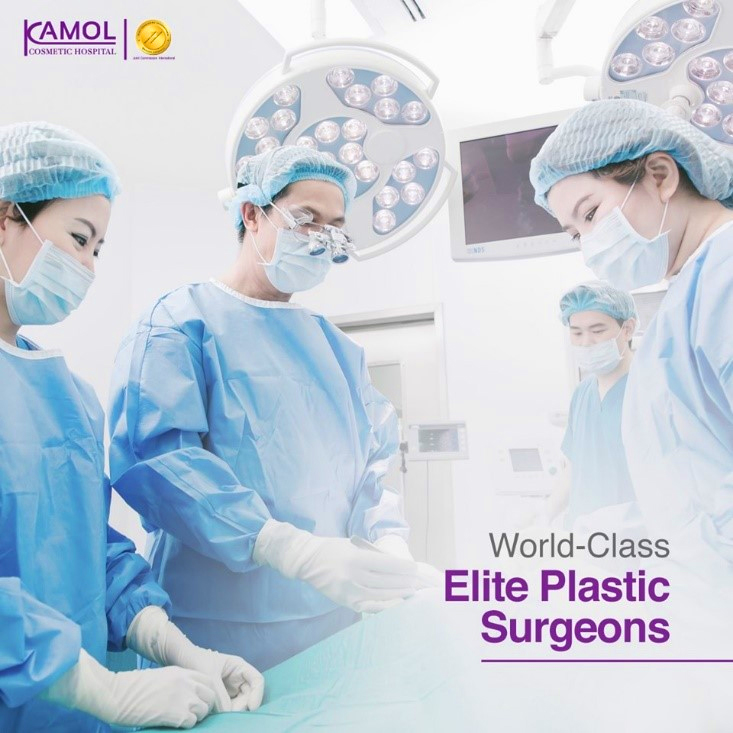服务页面
面部提拉是一种以创造年轻的面部外观的整容手术。这个手术可以减少脸颊和下颌的皮肤松弛或褶皱,以及任何因衰老而引起的变化。
有些情况下可能需要脸、眼和脖子一起来创造整个面部外观。将面部和颈部手术结合以达到这一目的是很常见的,如深层肌肉收紧、脂肪转移、面部骨骼增加和面部骨骼轮廓塑造以达到理想的年轻外观。
咖蒙美容医院提供整容和相关的程序。有人可能多个步骤结合,具体如下:
- 初级提拉/中级提拉
- 使用SMAS进行全面部提拉
- 使用可吸收的合成材料进行提拉
- 颈部提升和颈部整形
- 前额提升/眉部提升
- 面部脂肪转移修复
适合面部提拉的人
- 面部衰老
- 可以适应镇静剂及全身麻醉
- 有积极的态度及现实的期望
面部提拉的准备工作
在与医生协商并同意进行手术后,准备工作将按照以下步骤进行:
- 手术前至少戒烟两周
- 停止阿司匹林或任何干扰凝血的药物
- 体格检查及病史。外科医生需要病人的医疗记录。大多数40岁及40岁以上的患者需要咨询医生和心脏病专家,了解任何可能的心脏并发症,因为这在麻醉时是必要的
- 面部检查及面部轮廓分析
- 在手术前,用杀菌香皂清洗头发
- 对预期效果的确认,病人应该询问任何关于面部拉皮结果的问题,如对细纹的影响或面部对称
整容的过程
这个手术需要全身麻醉,虽然有时局部麻醉和镇静就足够了。整容手术大约需要2-4小时。由于需要面部、眼睛和颈部一起工作来创造一个整体的面部外观,通常是结合面部和颈部手术来实现最终效果。
在咖蒙美容医院,我们为那些寻求恢复年轻外表的人提供六种拉皮和相关的手术。
1. 初级提拉/中级提拉
这个手术需要两个切口;第一个是在颞部发际处做一个简单的皮肤切口,一直到耳朵的前部,最后到耳垂。这是一种至今仍在使用的标准程序。这种手术收紧多余的皮肤,完全依靠皮肤的张力来移动面部下面的软组织。第二个切口在睫毛下部附近。这个区域用于提紧面颊肌肉,多余的皮肤将减少以达到平衡。本术式适用于皮肤过多,上睑下垂程度较轻的深部柔软皮肤。
在镇静或全身麻醉下,这个过程大约需要2小时。
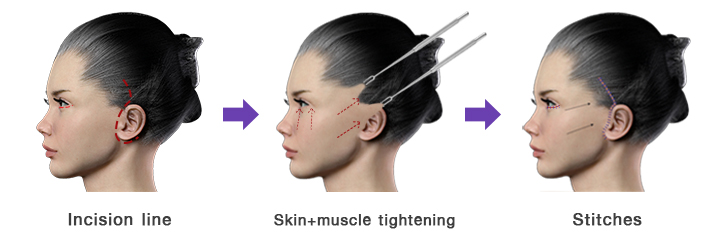
图1.显示初级提拉/中级提拉
2. 使用SMAS进行全面部提拉
我们的整形外科医生采用单独的SMAS皮瓣和SMAS切除术进行皮下拉皮。切口从颞部发际线开始,向下到耳朵前面,结束于耳朵后面。然后,SMAS将被尽可能紧密地向上和向后拉。皮下肌肉可能会收紧,皮下软组织和皮肤会随着SMAS皮瓣移动,然后切除多余的皮肤。这种手术是一种更有效的技术,效果也更持久。
本术式适用于皮肤过盛下垂、面部肌肉下垂的患者,使其面部恢复光滑、结实、年轻的面貌
在镇静或全身麻醉的情况下,这个手术大约需要3-4小时。
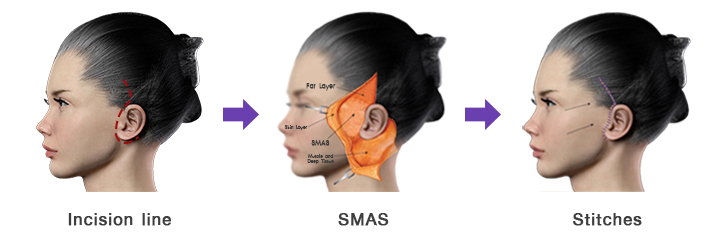
图2所示。显示“深部组织技术与SMASectomy”。
3. 使用可吸收的合成材料进行提拉
我们提供深层肌肉悬浮液与合成可吸收色带(Endotine®)的整容。切口位于耳前至颞区。Endotine®在6个月内可被吸收。这个程序可以提高脸颊的体积和突出,自然,年轻的外观。手术后几个月后,病人可能会感到一些不适。
本术式适用于中面部(内面部)上睑下垂,或需要增大面颊体积,且深层柔软皮肤上睑下垂小的患者。
在镇静或全身麻醉下,这个过程大约需要2小时。
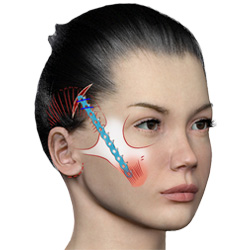
图3所示。合成可吸收材料(Endotine)深层肌肉悬浮液除皱术
4. 提颈/折颈
在这个过程中,帮助那些脖子粗大、有皱纹或下垂的人。外科医生会同时使用一种或两种方法。颈整形术是指外科医生在下巴-颈线下做一个小切口,小心地提起和收紧松弛的颈部肌肉(Platysmaplasty)。颈部提物的切口在每只耳后,也可以通过SMAS做一个较长的切口来拉伸颈部肌肉。去除多余下垂的皮肤,使颈部恢复光滑、结实和年轻的外观。这种手术通常与整个面部拉皮一起进行。
在镇静或全身麻醉的情况下,这个过程大约需要2-4小时。
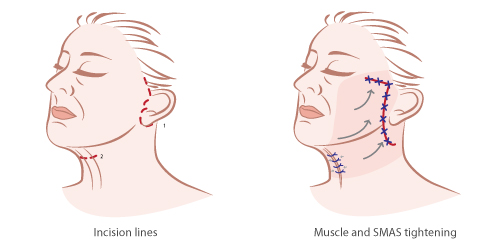
图4所示。显示颈部提升和颈部整形程序
5. 前额提升/眉部提升
提眉是重新定位眉毛,以达到更年轻的外观。切口疤痕在发际线后方1-2厘米。提眉有以下三种类型:
- 内窥镜提眉术,会产生一个极小的疤痕
- 颞部或有限的提眉术,切口在颞部左右两边
- 经典的提眉术,在发际线后面水平切开一个长长的切口。 (See More)
6. 面部脂肪转移修复
脂肪转移作为一种微移植物或纳米移植物来支持需要轮廓和实现的特定区域。此术式适用于面部较瘦、脂肪较松,且因面部体积不足而接受过面部提拉,但结果不理想的人。有些客户可能需要更多的手术来获得理想的年轻外观。经验丰富的外科医生可以推荐最好的选择,但最终的决定任在客户手上。
在镇静或全身麻醉下,这个过程大约需要1-2小时。
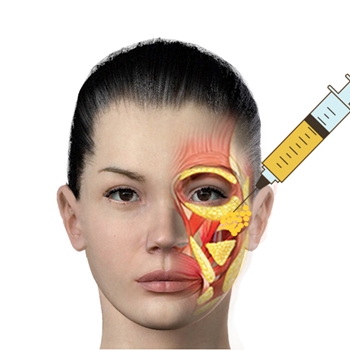
图5显示面部脂肪转移区域
提拉手术后的护理
- 尽量抬高脸部以减少肿胀
- 动作轻柔,支持血液循环
- 头三天要一直缠着加压绷带,然后在家修养一个月
- 术后一个月内避免剧烈运动
- 术后至少停止吸烟或饮酒两周
- 手术后5-10天左右拆线
- 与你的外科医生保持任何后续预约,检查愈合过程,并询问任何可能与你有关的问题
- 遵照所有术后指示并参加所有术后预约
整容的风险和并发症
拉皮的并发症将通过正确的护理、药物治疗或手术矫正来处理。这些风险包括:
- 术后皮下血肿
- 疤痕。面部整容手术留下的疤痕是永久性的,但通常会隐藏在头发下面。这是罕见的切口变成红色,凸起的疤痕。注射类固醇或其他治疗将用于改善外观。
- 神经损伤和感觉神经损伤,虽然影响是自限性的,通常在6-12个月内恢复。
- 皮肤脱落,虽然非常罕见,但仍然会发生。整容手术可能会中断血液供应,可能导致部分皮肤坏死和延迟愈合。
- 其他风险和并发症与其他大型手术相似,包括麻醉的副作用。自身的生活方式和已有的医疗条件可能增加风险。
面部整容手术后恢复
手术后几天,淤青、肿胀、过敏和麻木会使你感到不适。面部和颈部几周后会开始好转,然后可以开始轻柔按摩,刺激神经和淋巴引流,以减少肿胀和恢复期。手术后14天就可以恢复工作了,但是仍然会有一些肿胀。手术后4周可以开始恢复锻炼。最终结果需要6 - 12个月。


